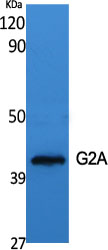G2A Polyclonal Antibody
- Catalog No.:YT1807
- Applications:WB;IF;ELISA
- Reactivity:Human;Mouse;Monkey
- Target:
- G2A
- Gene Name:
- GPR132
- Protein Name:
- Probable G-protein coupled receptor 132
- Human Gene Id:
- 29933
- Human Swiss Prot No:
- Q9UNW8
- Mouse Gene Id:
- 56696
- Mouse Swiss Prot No:
- Q9Z282
- Immunogen:
- The antiserum was produced against synthesized peptide derived from human GPR132. AA range:293-342
- Specificity:
- G2A Polyclonal Antibody detects endogenous levels of G2A protein.
- Formulation:
- Liquid in PBS containing 50% glycerol, 0.5% BSA and 0.02% sodium azide.
- Source:
- Polyclonal, Rabbit,IgG
- Dilution:
- WB 1:500 - 1:2000. ELISA: 1:20000. IF 1:100-300 Not yet tested in other applications.
- Purification:
- The antibody was affinity-purified from rabbit antiserum by affinity-chromatography using epitope-specific immunogen.
- Concentration:
- 1 mg/ml
- Storage Stability:
- -15°C to -25°C/1 year(Do not lower than -25°C)
- Other Name:
- GPR132;G2A;Probable G-protein coupled receptor 132;G2 accumulation protein
- Observed Band(KD):
- 42kD
- Background:
- This gene encodes a member of the guanine nucleotide-binding protein (G protein)-coupled receptor (GPCR) superfamily. The receptors are seven-pass transmembrane proteins that respond to extracellular cues and activate intracellular signal transduction pathways. This protein was reported to be a receptor for lysophosphatidylcholine action, but PubMedID: 15653487 retracts this finding and instead suggests this protein to be an effector of lysophosphatidylcholine action. This protein may have proton-sensing activity and may be a receptor for oxidized free fatty acids. Alternative splicing results in multiple transcript variants. [provided by RefSeq, Jul 2013],
- Function:
- caution:Was originally (PubMed:11474113) thought to be a receptor for lysophosphatidylcholine (LPC) and sphingosylphosphorylcholine (SPC), However, this work has been retracted.,function:Receptor for an unknown ligand. Activates a G alpha protein, most likely G alpha(q). May be involved in apoptosis. Functions at the G2/M checkpoint to delay mitosis. May serve as a mechanism for T- and B-cells, and other cell types, to slow their proliferation and repair damaged DNA to ensure proper replication.,induction:By stress and DNA-damaging agents.,similarity:Belongs to the G-protein coupled receptor 1 family.,subcellular location:Internalized and accumulated in endosomal compartments. LPC triggers the relocalization from the endosomal compartment to the cell surface.,tissue specificity:Highly expressed in macrophages and hematopoietic tissues rich in lymphocytes, like spleen and thymus. Weakly e
- Subcellular Location:
- Cell membrane ; Multi-pass membrane protein . Internalized and accumulated in endosomal compartments. LPC triggers the relocalization from the endosomal compartment to the cell surface (By similarity). .
- Expression:
- Highly expressed in macrophages and hematopoietic tissues rich in lymphocytes, like spleen and thymus. Weakly expressed in heart and lung. In atherosclerotic plaques, expression is observed around the lipid core and at the shoulder region.
- June 19-2018
- WESTERN IMMUNOBLOTTING PROTOCOL
- June 19-2018
- IMMUNOHISTOCHEMISTRY-PARAFFIN PROTOCOL
- June 19-2018
- IMMUNOFLUORESCENCE PROTOCOL
- September 08-2020
- FLOW-CYTOMEYRT-PROTOCOL
- May 20-2022
- Cell-Based ELISA│解您多样本WB检测之困扰
- July 13-2018
- CELL-BASED-ELISA-PROTOCOL-FOR-ACETYL-PROTEIN
- July 13-2018
- CELL-BASED-ELISA-PROTOCOL-FOR-PHOSPHO-PROTEIN
- July 13-2018
- Antibody-FAQs
- Products Images

- Immunofluorescence analysis of A549. 1,primary Antibody was diluted at 1:200(4°C overnight). 2, Goat Anti Rabbit IgG (H&L) - Alexa Fluor 488 Secondary antibody was diluted at 1:1000(room temperature, 50min).3, Picture B: DAPI(blue) 10min.

- Western Blot analysis of various cells using G2A Polyclonal Antibody diluted at 1:500
.jpg)
- Western Blot analysis of 293T cells using G2A Polyclonal Antibody diluted at 1:500

- Western blot analysis of lysates from COS7 cells, using GPR132 Antibody. The lane on the right is blocked with the synthesized peptide.



